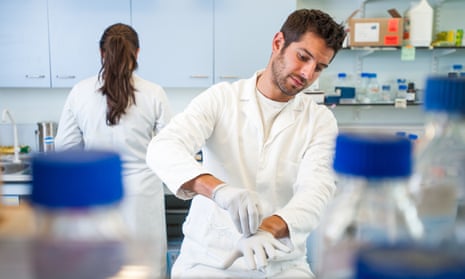A disproportionate number of medical students in the UK come from the most affluent homes and neighbourhoods, a survey of nearly 33,000 applicants has found.
The study by academics at Dundee and Central Lancashire universities of applications to 22 medical schools also found that applicants from the wealthiest backgrounds – particularly in Scotland and Wales – were more likely to be given places than applicants from poorer homes.
The data has reinforced longstanding anxieties that Britain’s doctors and surgeons fail to mirror the profile of society: 80% of medical students came from households containing professionals or those in higher managerial roles, and more than a quarter from private schools.
Katie Petty-Saphon, chief executive of the Medical Schools Council (MSC), the sector’s representative body, said medical schools were deeply concerned by the issue. They had already been shocked by “completely appalling” figures showing that 50% of secondary schools had never had a pupil apply to medical school.
“We need to access the widest possible talent pool because it is both a privilege and a responsibility to become a doctor,” she said. “We need to make sure we have the right opportunities for all those pupils who have the right aptitude to be excellent professionals.”
The study, entitled Fair Access to Medicine? and undertaken on behalf of the UK Clinical Aptitude Test Board – a selection body run by a consortium of medical and dental schools – covered applications over three years from 2010 to 2012. It found medical students from England were, relatively speaking, from a broader cross-section of society than in Scotland, Wales and Northern Ireland, where medical school recruits were drawn far more heavily from the highest socio-economic groups and professional homes.
Among English students, 38% came from the most affluent 20% of postcodes, compared with 54% of those in Scotland, 55% from Wales and 51% in Northern Ireland. In England, 8.7% of medical students were from the poorest 20% by postcode, against 4.3% in Scotland, 6.5% in Wales and 3.2% in Northern Ireland.
The researchers also found that while 12% of applicants across the UK came from the poorest 20% of neighbourhoods, only 7.6% of places at medical school went to people from those areas. By contrast, 42% of places were awarded to students from the richest 20%, even though only 36% of applicants came from those areas.
In Scotland, where private schooling is far more prevalent for the middle classes in several areas, particularly Edinburgh, 35% of medical students came from fee-paying schools against a UK average of 27%.
And in Scotland, 86% had parents in the highest ranked professional group – the highest proportion of the four UK nations, against a UK average of 80%. In England, 29% were privately educated and a further 22% came from selective grammar schools.
The researchers on the study warned there were differences in the way different parts of the UK measured socio-economic data by postcode, which could influence the final figures. Some postcodes were more socially mixed than others.
They also suspected that England’s relatively broader cross-section could be linked to higher levels of immigration: families that have relatively recently arrived in the UK may be more likely to live in poorer neighbourhoods, with less prestigious jobs, but have high aspirations for their children.
The authors said there was an urgent need to find valid and accurate measures across all four parts of the UK to ensure the data was wholly comparable – a recommendation welcomed by the MSC. Research is also being commissioned into framing the complex selection tests more fairly, to check whether the current system discriminates against pupils from poorer backgrounds.
The names of the 22 medical schools involved in the study were kept confidential, but researchers found wide disparities between them. At one school just 1.5% of students admitted had parents in the two lowest ranked occupational groups.
The best performing school appeared to be making efforts to widen access. Eight percent of its students had parents in the two lowest-ranked occupational groups – a higher proportion from that group than had applied.
The British Medical Association and MSC believe more progress on widening access will be made by tackling the problem at primary and secondary school level: by increasing the confidence and ambitions of younger pupils, and by urging schools and education authorities to promote medicine regardless of a child’s background.
Under the Primary Futures project, backed by the National Association of Head Teachers, the UK’s chief medical officers and the MSC, doctors and figures such as Catherine Calderwood, Scotland’s CMO, have visited schools to promote the profession.
Medical students active with the BMA have run similar projects. Mita Dhullipala, a fourth year student at Glasgow medical school and an active member of the BMA’s students committee, has done outreach work at schools in Springburn, a district of Glasgow with some of the UK’s worst rates of deprivation and early mortality.
After attending both state and private schools, Dhullipala said she had found the pastoral care and support for pupils at fee-paying schools was far greater than in state schools. Private schools’ resources meant they were more often able to treat pupils as the “complete package”.
“I have come to realise it’s really not about university. There’s little point in universities setting up more schemes if the uptake isn’t there,” she said. “There’s a need for educational reform, more funding put into the education system and there needs to be better pastoral care in state schools.”









Comments (…)
Sign in or create your Guardian account to join the discussion